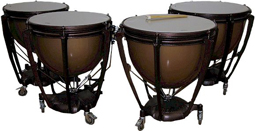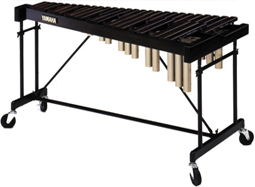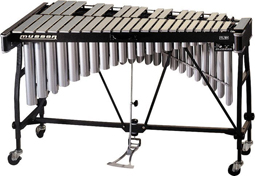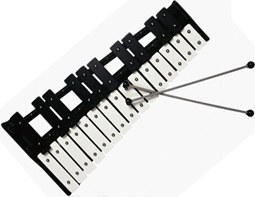Contents:
Tuned percussion is as it sounds, itís percussion that is tuned and is able to play notes from a stave as any other instrument, whether it is melody, chords or bass. Below are some of the more common instruments in the tuned percussion section of the orchestra.

#1: Timpani
Timpani
The timpani are one of the oldest instruments in the percussion section and are usually used to accent the bass in orchestral music.
There are many sizes of timpani used in the orchestra today from as big as 33 inches in diameter all the way down to 12 inches and smaller. The 33 inch timpani can reach a C below the stave in the bass clef where as the 12 inch can reach into the treble clef (image #2).
The timpani is notate on a single stave and in the bass clef.
The timpani are fitted with pedals; these pedals are used to change from pitch to pitch within their range. Donít mistake this ability and think that the timpani can play a succession of chromatic notes, they canít. They can play selected notes that the performers tune to, but this doesnít mean you canít change these notes during a performance. If a change in notes is required some time is needed to retune the timpani.

#2: Timpani range
Timpani are normally played by hitting them with special mallets, these come in hard, medium, and soft and all have different tones and sounds to them. Write hard, medium, or soft sticks above the stave to specify. Back to top

#3: Xylophone
Xylophone
The xylophone is a keyboard type instrument made of wooden blocks tuned like piano. Because itís made of wood, the sustain of any note is very little. To sustain a note the performer must use two mallets and roll on the note(s). this is notated like a tremolo, with three lines on the stem or above or below the note if there is no stem.

#4: Xylophone's range
The xylophone is notated on a single stave in the treble clef and sounds an octave higher than written.
The xylophone is also played using two mallets, one in each hand and come in hard, medium, and soft and all have different tones and sounds to them. Write hard, medium, or soft sticks above the stave to specify. Back to top

#5: Marimba
Marimba
Almost exactly like the xylophone but sounding an octave lower and sounds at written pitch. It has a range of four octaves and has a deeper and mellower tone.

#6: Marimba's range
Performers will normally use two mallets in each hand this time but playing technique is exactly the same as the xylophone. All the same mallets are used for the marimba as are for the xylophone except for really hard sticks.
The marimba is notated on either a single stave in treble or bass clef or a double stave with a treble clef on the top and a bass clef on the bottom. Back to top
Vibraphone

#7: Vibraphone
This is similar in design to the xylophone and marimba; its bars are made from metal instead of wood and it has an added motor which turn fans inside the resonator tubes below the bars so it gives the tone a vibrato effect. This motor can be on or off and the fan speed can be altered to give a slow or fast vibrato, the motor on or off and speed should be specified at the beginning of the score and part. With the motor off the sustain of the notes is still quite short but with the motor on the sustain is considerable longer and the whole tone comes to life.

#8: Vibraphone's range
Just like a piano the vibraphone has sustaining pedal which is controlled by the foot. This allows the performer to sustain or dampen the notes. When writing music for the instrument it is best to let the performer know how it should be played by writing Ďl.v.í (let vibrate) over the notes or chords.
Mallets are used again for the vibraphone and come in hard, medium and soft. Back to top

#9: Glockenspiel
Glockenspiel
The glockenspiel is formed of steel bars set out like a keyboard. Because of its very high pitch the glockenspiel can be heard over a full orchestra. The glockenspiel, like the xylophone, is a transposing instrument and sounds two octaves higher then the pitch written.
Hard and soft mallets are used on the glockenspiel, but to get loudest results performers will use brass mallets.

#10: Glockenspiel's range
The sustain on the glockenspiel is quite long, but to sustain it a bit longer and add a vibrato to the tone the performer can wave their had back and forth very close the bars just after they have been hit. Back to top